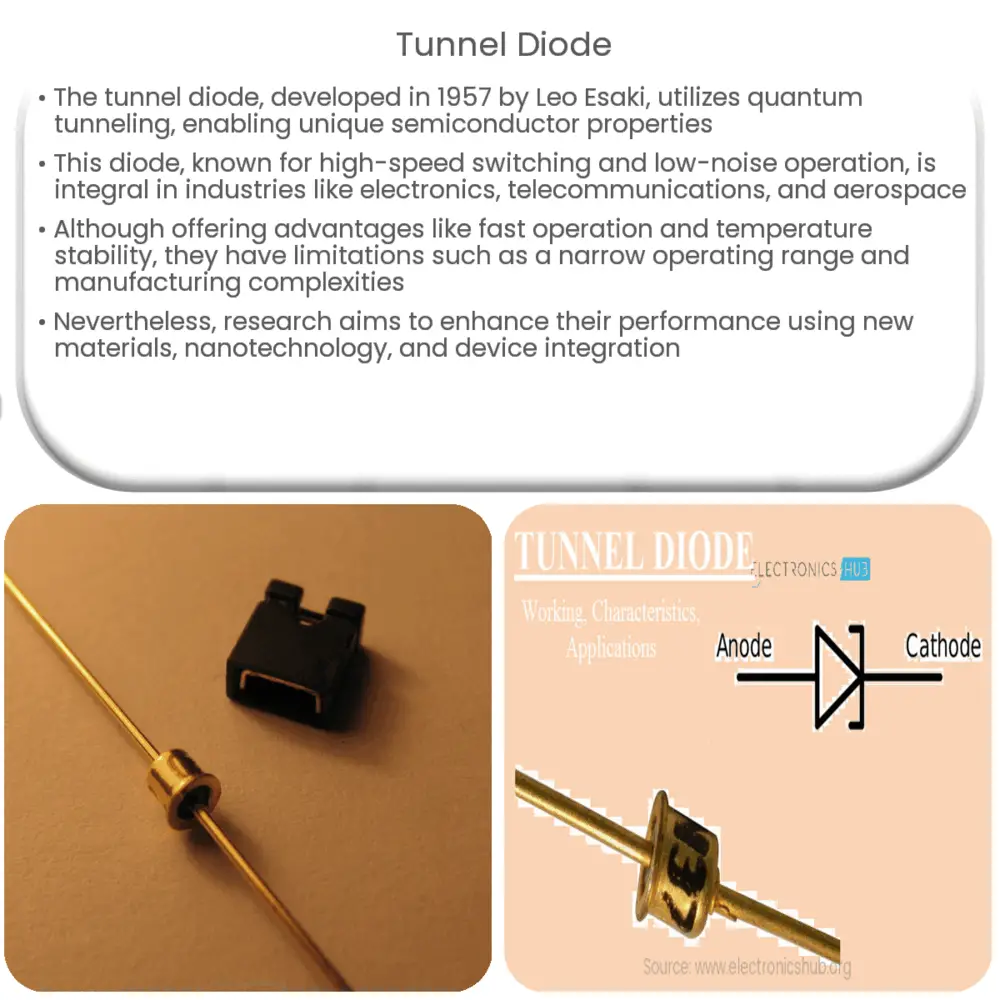A tunnel diode is a high-speed semiconductor device that leverages quantum tunneling for low-voltage operation and low-noise performance.

Tunnel Diode: Overview and Applications
Introduction
The tunnel diode, invented in 1957 by physicist Leo Esaki, is a type of semiconductor diode that has unique properties due to the quantum mechanical effect called quantum tunneling. This high-performance diode has found applications in various industries, including electronics, telecommunications, and aerospace, where high-speed switching and low-noise operation are required.
Quantum Tunneling and the Tunnel Diode
Quantum tunneling is a phenomenon in which particles pass through barriers that would be insurmountable according to classical physics. In the context of a tunnel diode, electrons can “tunnel” through the depletion region between the p-type and n-type semiconductor materials, even when the voltage applied across the diode is low.
The tunnel diode is formed by heavily doping both the p-type and n-type semiconductor materials, creating a narrow depletion region and enabling a high concentration of charge carriers. As a result, the diode exhibits a negative resistance region in its current-voltage (I-V) characteristic curve, allowing for rapid switching between conducting and non-conducting states.
Characteristics and Advantages
Tunnel diodes offer several benefits over conventional diodes, including:
- High-speed operation: Tunnel diodes are capable of switching between conducting and non-conducting states in picoseconds, making them suitable for high-frequency applications.
- Low voltage operation: Due to the quantum tunneling effect, tunnel diodes can operate at low voltages, which is beneficial for low-power electronic devices.
- Low noise: Tunnel diodes produce less noise compared to other diodes, making them ideal for use in sensitive electronics and communication systems.
- Temperature stability: The performance of tunnel diodes remains relatively stable over a wide temperature range, making them suitable for various operating environments.
Applications
Tunnel diodes have found applications in several industries, such as:
- Electronics: Tunnel diodes are used in high-speed electronic devices, including oscillators, amplifiers, and switches, due to their fast switching capabilities and low noise generation.
- Telecommunications: In microwave and radio frequency communication systems, tunnel diodes serve as low-noise amplifiers and oscillators, ensuring clear and stable signal transmission.
- Aerospace: The temperature stability and low-power operation of tunnel diodes make them well-suited for use in satellite and spacecraft electronics, where reliable performance is essential.
Limitations and Challenges
Despite their advantages, tunnel diodes also have certain limitations and challenges:
- Narrow operating range: The negative resistance region in the tunnel diode’s I-V characteristic curve is relatively narrow, making it challenging to design stable circuits that operate within this range.
- Manufacturing complexity: The heavy doping required for tunnel diodes makes their fabrication process more complex and costly compared to conventional diodes.
- Decreased popularity: The emergence of newer semiconductor devices, such as high electron mobility transistors (HEMTs) and Schottky diodes, has led to a decline in the popularity of tunnel diodes, as these devices offer improved performance in some applications.
Improvements and Future Outlook
Research and development efforts continue to focus on improving the performance and capabilities of tunnel diodes. Some areas of investigation include:
- New materials: Exploring alternative semiconductor materials, such as gallium nitride (GaN) and silicon carbide (SiC), could lead to enhanced tunnel diode performance and broader application possibilities.
- Nanotechnology: Advances in nanotechnology and nanoscale fabrication techniques could enable the development of smaller, more efficient tunnel diodes for use in next-generation electronic devices.
- Integration with other devices: Combining tunnel diodes with other semiconductor devices, such as transistors and resonant tunneling diodes (RTDs), could lead to innovative hybrid circuits with unique characteristics and potential applications.
Conclusion
Tunnel diodes, with their unique quantum tunneling-based operation, have played a crucial role in various industries, from electronics to aerospace. Although they face competition from newer semiconductor devices, ongoing research and development efforts continue to explore new materials, nanoscale fabrication techniques, and device integration possibilities. These advancements may lead to the development of improved tunnel diodes, capable of addressing the limitations of current designs and opening up new application areas for this fascinating and versatile semiconductor device.

